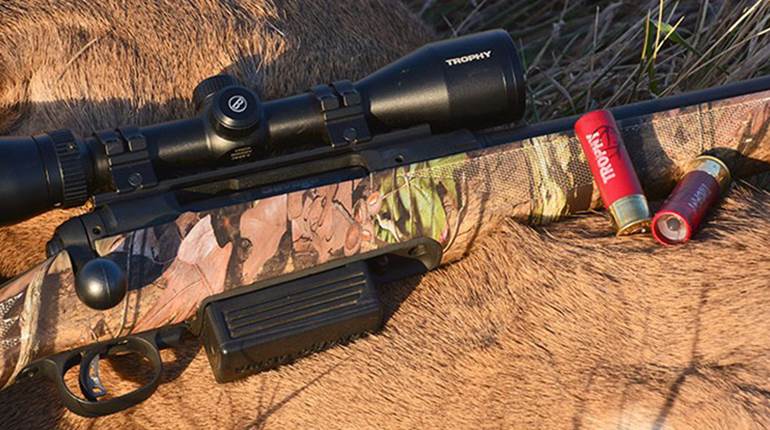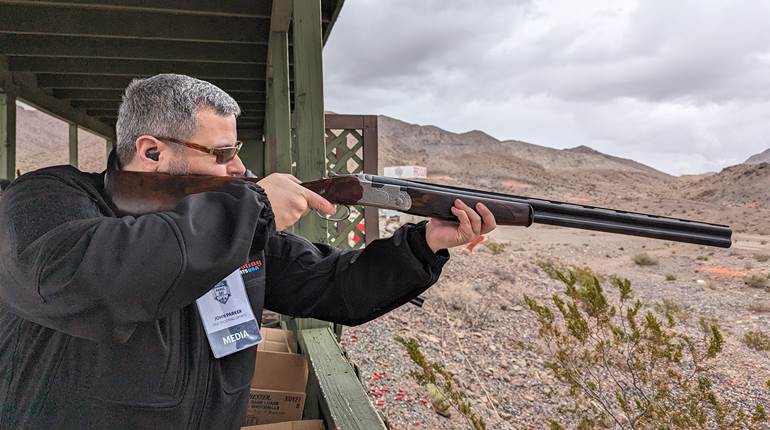
In 1948 Stefano Fausti began making shotguns in Italy’s Gardone Valley. Leadership of the company, Fausti Stefano S.R.L., has since passed to his three daughters: Barbara, Elena and Giovanna. Specific Fausti models have been brought into the United States by several importers through the years, including American Arms, Traditions, Cabela’s and Weatherby. In 2009, Fausti USA was established in Fredericksburg, Va., and in its first year the company will import Class and Caledon over-unders as well as the Dea and Dea Round Body boxlock side-by-sides.
We selected the side-by-side, English-stocked 28-gauge Dea for evaluation, as this is a true 28-gauge-sized frame measuring a mere 1.75 inches across the bolsters, and the petite action is only 1.83-inches high at its tallest. The Dea, which is Italian for goddess, is available as a 28 gauge or as the Dea Duetto, a two-barrel set with additional .410-bore barrels on the 28-gauge frame. The little boxlock is styled and stocked after traditional English game guns and weighs less than 5 pounds.
The Dea’s receiver is based on the classic Anson & Deeley action, and its barrels are assembled on the monobloc principle in which the barrel tubes are soldered into a breech section containing the locking lumps. Lockup is achieved using the proven double-under-lump system with a lug on the forward lump extending down through the bottom of the receiver body. Moving the checkered top lever to the right moves the double locking lugs rearward and out of their recesses in the lumps, allowing the action to open. Ejection is selective automatic, and the bottom of the bases of the ejectors/extractors is rectangular in shape. Sears mounted in the fore-end iron power the ejectors to kick out the hulls if the shotshell has been fired, or merely extracts the shotshells if unfired.
Case-coloring adorns the Dea’s steel receiver, and well-executed, full-coverage, laser-engraved English scrollwork covers its left, right and bottom, as well as the blue top lever, trigger guard and rear of the fore-end iron. As an aesthetic touch, the Fausti crest is inlaid in gold on the receiver’s underside. Mounted on the tang, the safety is manually operated. Pressing rearward reveals an “S” engraved on the tang and engages the safety.
The trigger is a single, non-selective mechanical unit with a blue blade that fires the right barrel first. A connector prevents the left sear from releasing the hammer to travel forward until the right hammer has fired, preventing doubling.
Barrels are cold-blued, and our 28-inch-barreled sample exhibited fine polish. The top rib is raised and grooved to reduce glare, and it is topped by a brass bead a 1/4 inch back from the muzzle. There is engraving at the rear of the chambers on the barrels surrounding where they join the monobloc. The forcing cones are lengthened and the right bore measures 0.550 inches, and the left measures 0.549 inches. As 0.550 inches is the nominal bore diameter for 28 gauge, it is obviously not backbored or overbored. The 28-gauge Dea comes with five interchangeable choke tubes: cylinder, improved-cylinder, modified, improved-modified and full, as well as a choke tube wrench. A fitted and internally padded case and sleeves for the barrels and receiver also come with the gun.
The oil-finished AAA European walnut stock was well-grained and, as a cushioned recoil pad is unnecessary with a 28 gauge, the butt is capped by a well-fitted walnut pad with horizontal grooves to aid in gripping on the shoulder. All dimensions are minimalist, and the straight grip measured a mere 4 1/2 inches in circumference. Wood-to-metal fit was universally proud around the receiver. The fore-end is of the splinter style with a squared bottom, and it, like the wrist, is checkered in a 24-line-per-inch bordered double-diamond pattern. A flush-fitting, blue diamond-shaped plate hides the screw retaining the fore-end iron. An Anson-style pushrod with a grooved button at its front releases the fore-end from its hanger when depressed.
At the range, the Dea was fired at both five-stand sporting clays and at skeet. It was also carried for a few days of unsuccessful grouse hunting. No fault could be attributed to the gun, as it was a delight to carry, but the grouse simply refused to cooperate. More than 600 rounds were fired without a malfunction with loads from Remington, Winchester and Federal Premium, and the gun was patterned at 40 yards. The lightweight, handy Dea pointed extremely well and was a joy to shoot, enabling one shooter to hit 44 out of 50 at American skeet—about what he does on a good day with a 12-gauge over-under. Some here believe the 28 gauge to be an overachiever given its charge weights, and the Dea reinforced that opinion. The Dea is fast and light, but the 28-inch barrels helped prevent the little gun from being too whippy at clay targets. That said, the Dea wasn’t designed for clays, and it makes for an ideal little upland gun.
Now that Fausti has its own U.S. subsidiary, it can import its full line of shotguns, ranging from $60,000 external hammer side-by-sides to affordable autoloaders, and the Dea is an excellent little gun to build upon. At just under $5,000, the Dea is not inexpensive, but in the hands it swings like a much more expensive gun.
Manufacturer : Fausti Stefano S.R.L., Via Martiri Dell’ Indipendenza 70
Importer: Fausti USA; (540) 371-3287; Faustiusa.com
Gauge: 28, 3"
Action Type: Side-by-side, boxlock shotgun
Receiver: Case-colored steel
Barrels: 28" blued
Chokes: Interchangeable: cylinder, improved-cylinder, modified, improved-modified and full
Trigger: Single, non-adjustable, non-selective, mechanical 4-lb. pull right barrel; 4-lb., 1-oz. pull left barrel
Stock: Oil-finished AAA European walnut: length of pull, 141⁄4"; drop at heel, 23⁄16"; drop at comb, 17⁄8"
Overall Length: 441⁄8"
Weight: 4 lbs., 13 ozs.
Accessories: Locking fitted plastic case, cloth sleeves, five choke tubes, choke tube wrench
Suggested Retail Price: $4,999






































